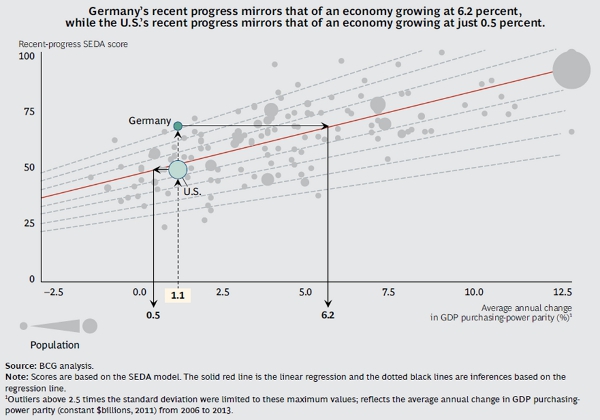 For more than 70 years, GDP has been the most common method for measuring the economic activity of nations. But as a measure, GDP is incomplete, as it does not encompass important factors such as well-being. In new research which applies over 40 indicators covering economics, investments and sustainability to 149 countries, Enrique Rueda-Sabater examines how countries perform in converting their GDP growth into improvements in well-being for their citizens. While some countries, such as Brazil, are very good at converting growth into well-being, others like the United States, are less so. He writes that governments can take lessons from these results on how to devise inclusive long-term growth strategies.
For more than 70 years, GDP has been the most common method for measuring the economic activity of nations. But as a measure, GDP is incomplete, as it does not encompass important factors such as well-being. In new research which applies over 40 indicators covering economics, investments and sustainability to 149 countries, Enrique Rueda-Sabater examines how countries perform in converting their GDP growth into improvements in well-being for their citizens. While some countries, such as Brazil, are very good at converting growth into well-being, others like the United States, are less so. He writes that governments can take lessons from these results on how to devise inclusive long-term growth strategies.
Achieving rapid economic growth in terms of GDP is a limited measure of a country’s development success, as it ignores other important factors such as well-being. However, GDP has been the main way in which success has been measured. A key objective of our new report, Why Well-Being Should Drive Growth Strategies, the 2015 Sustainable Economic Development Assessment (SEDA) has been to develop a measure of well-being that could be used to benchmark countries against the rest of the world and against their most relevant peers. We have done that—building on academic work and from international organisations—because we saw a need for a practical diagnostic toolkit that could help governments to guide the formulation of inclusive growth strategies.
Measurement helps focus and we hope that our report also serves as a contribution to the broader effort of ensuring a focus on development goalposts that goes beyond economic growth. And we believe this is in line with the spirit of the discussions under way at the United Nations towards a new set of Sustainable Development Goals. Our analysis is organized around three elements: Economics (including the pace of growth, stability and employment creation), Investments (health, education and infrastructure) and Sustainability (broadly defined to encompass both social inclusion and the environment). It relies solely on objective indicators, as we believe that subjective measures of well-being have a valuable role to play, but are better used in parallel rather than in combination with objective ones.
We use a total of 43 indicators around those three elements to construct a relative score of well-being for 149 countries. By looking at the snapshot of SEDA scores in connection with a country’s per capita income we explore differences in how countries are translating their current wealth into well-being for their citizens. Similarly, by comparing the evolution of countries’ SEDA scores over seven years with GDP growth rates for the same period, we explore different performance in converting economic growth into well-being improvements (our data covers the period up to 2013).
Our work provided confirmation for some expected patterns and it has also shed some new light on other dynamics. We confirmed that for instance: Northern European countries (with Norway in the pole position) lead the world in terms of current well-being; oil-rich countries are not performing well in translating their wealth into well-being; and there is a pervasive tension between growth and environmental protection.
Among other findings the following are worth noting in terms of individual countries: Singapore emerges as one of the top scorers in current well-being—the only non-European country at that level; Poland has made great recent progress in well-being and is the top performer in converting growth into well-being; and Rwanda has made the greatest recent progress—albeit from a weak starting position.
Among major countries Brazil is one of the countries making the most of its economic growth in terms of converting it into well-being improvements. China is only converting its growth into well-being at global average rates … but that is quite remarkable considering its very rapid growth pace in recent years. As Figure 1 shows, the contrast between Germany and the USA provides a good illustration of the value of looking at well-being dynamics rather than just GDP growth. Between 2006 and 2013, both countries had similar low growth rates—averaging just over one percent annually—but Germany, like Brazil, generated well-being improvements that would have been expected of a country growing much faster while the USA was not even improving well-being at a rate commensurate with its economic growth.
Figure 1: The U.S. and Germany grew at the same rates but converted this growth to well-being at different rates, 2006- 2013

It is clear that economic growth is a necessary condition for major improvements in well-being but also that it is far from sufficient. There is much that can be learned from countries that are performing well in converting wealth and economic growth into well-being. Establishing where gaps exist with respect to peers can guide the setting of priorities and identifying comparable countries with better performance can point to the development of strategies to address those gaps. And it is not all about expenditure: while some key investments require major budget outlays, some policies that result in greater well-being do not have to be costly.
Finally, a warning flag from our analysis is that sustainable progress in well-being is more difficult to achieve than short-term economic growth and that countries with weak sustainability find it hard to reduce that gap. This underscores the importance for leaders and policymakers across the globe to implement, within their development strategies, the institutional foundations that form the basis of long-term sustainability.
This article is based on the report ‘Why Well-Being Should Drive Growth Strategies’, the 2015 Sustainable Economic Development Assessment, from The Boston Consulting Group.
Please read our comments policy before commenting.
Note: This article originally appeared at our sister site, USAPP – American Politics and Policy. It gives the views of the author, not the position of EUROPP – European Politics and Policy, nor of the London School of Economics. Featured image credit: Simon Cunningham (Flickr, CC-BY-2.0)
Shortened URL for this post: http://bit.ly/1SRaj3Y
_________________________________
 Enrique Rueda-Sabater – The Boston Consulting Group/ Center for Global Development
Enrique Rueda-Sabater – The Boston Consulting Group/ Center for Global Development
Enrique is a Senior Adviser to The Boston Consulting Group and a Visiting Fellow at the Center for Global Development. His earlier career at the World Bank spanned two decades, including four years as Director for Corporate Strategy.




Why do you use Brazil as an example of converting GDP into well-being? The Brazilian Spring of 2013 is an indicator that the country has not been a model for success in this area. I might not agree with everything that Davey Harvey Distinguished Professor of Anthropology and Geography at the Graduate Center of the City of New York has to say in his critiques on capitalism. However, when it comes to Brazil I agree with much of his analysis on the well-being of Brazilians.
http://davidharvey.org/2013/03/david-harvey-in-brazil-march-21-26/
I think they used Brazil as an example of efficient conversion of GDP to well-being, but not necessarily of top tier well-being.
Brazil might lack in providing well-being objectively, but in context with its GDP, it is more efficient than the United States. However, as you pointed out, comparative statements like that are troublesome because they don’t show the whole picture. In 2015, the United States had a GDP of 18.6 trillion USD compared to Brazil’s GDP of 1.76 trillion (according to the United Nations). With a GDP more than 10x higher than Brazil’s, the United States would need a well being over 10x higher than Brazil to be as efficient at converting GDP to well-being, which is fairly unlikely considering Brazil is a decently developed nation. In fact, lower GPD makes it easier to have an efficient/good conversion rate to well-being because it means the well-being measurement can be lower as well. So a middle ground of medium GDP (or at least not being the highest like the United States) with a high well-being score, which is getting easier and easier to achieve due to technology etc, is the best way to have a good “GDP to well-being conversion ratio.”